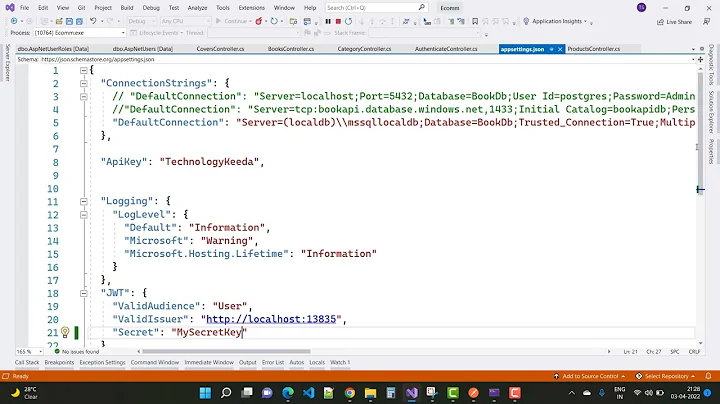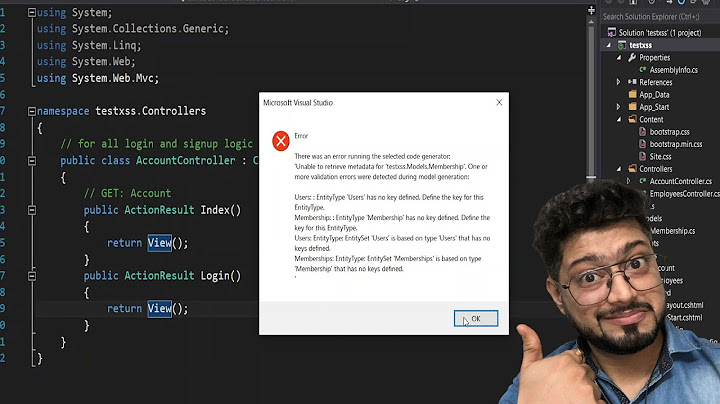Key Error: None of [Int64Index...] dtype='int64] are in the columns
Solution 1
You created your scaled_inputs_all DataFrame using loc
function, so it most likely contains no consecutive indices.
On the other hand, you created shuffled_indices as a shuffle
from just a range of consecutive numbers.
Remember that scaled_inputs_all[shuffled_indices] gets rows
of scaled_inputs_all which have index values equal to
elements of shuffled_indices.
Maybe you should write:
scaled_inputs_all.iloc[shuffled_indices]
Note that iloc provides integer-location based indexing, regardless of
index values, i.e. just what you need.
Solution 2
might have someone also get the same error in working with KFOLD in machine learning.
And the solution for this is as below:
You need to use iloc:
X_train, X_test = X.iloc[train_index], X.iloc[test_index]
y_train, y_test = y.iloc[train_index], y.iloc[test_index]
Solution 3
I had this problem too. I solved it by changing the data frame and series to array.
try the follwing codeline:
scaled_inputs_all.iloc[shuffled_indices].values
Solution 4
If you reset your index after dropping rows from your dataframe, this should stop the key error.
You can do this by running this after you run df.drop:
df = df.reset_index(drop=True)
Or, equivalently:
df.reset_index(drop=True, inplace=True)
Related videos on Youtube
Ashley E.
Hey all! My name is Ashley. I'm a new mom who is studying front end development to reenter the work force as a new career. Hope to help out you guys and make friends :^)
Updated on February 05, 2021Comments
-
Ashley E. over 3 years
I'm trying to shuffle my indices using the np.random.shuffle() method, but I keep getting an error that I don't understand. I'd appreciate it if someone could help me puzzle this out. Thank you!
I've tried to use the delimiter=',' and delim_whitespace=0 when I made my raw_csv_data variable at the beginning, as I saw that as the solution of another problem, but it kept throwing the same error
import pandas as pd import numpy as np from sklearn.preprocessing import StandardScaler #%% raw_csv_data= pd.read_csv('Absenteeism-data.csv') print(raw_csv_data) #%% df= raw_csv_data.copy() print(display(df)) #%% pd.options.display.max_columns=None pd.options.display.max_rows=None print(display(df)) #%% print(df.info()) #%% df=df.drop(['ID'], axis=1) #%% print(display(df.head())) #%% #Our goal is to see who is more likely to be absent. Let's define #our targets from our dependent variable, Absenteeism Time in Hours print(df['Absenteeism Time in Hours']) print(df['Absenteeism Time in Hours'].median()) #%% targets= np.where(df['Absenteeism Time in Hours']>df['Absenteeism Time in Hours'].median(),1,0) #%% print(targets) #%% df['Excessive Absenteeism']= targets #%% print(df.head()) #%% #Let's Separate the Day and Month Values to see if there is correlation #between Day of week/month with absence print(type(df['Date'][0])) #%% df['Date']= pd.to_datetime(df['Date'], format='%d/%m/%Y') #%% print(df['Date']) print(type(df['Date'][0])) #%% #Extracting the Month Value print(df['Date'][0].month) #%% list_months=[] print(list_months) #%% print(df.shape) #%% for i in range(df.shape[0]): list_months.append(df['Date'][i].month) #%% print(list_months) #%% print(len(list_months)) #%% #Let's Create a Month Value Column for df df['Month Value']= list_months #%% print(df.head()) #%% #Now let's extract the day of the week from date df['Date'][699].weekday() #%% def date_to_weekday(date_value): return date_value.weekday() #%% df['Day of the Week']= df['Date'].apply(date_to_weekday) #%% print(df.head()) #%% df= df.drop(['Date'], axis=1) #%% print(df.columns.values) #%% reordered_columns= ['Reason for Absence', 'Month Value','Day of the Week','Transportation Expense', 'Distance to Work', 'Age', 'Daily Work Load Average', 'Body Mass Index', 'Education', 'Children', 'Pets', 'Absenteeism Time in Hours', 'Excessive Absenteeism'] #%% df=df[reordered_columns] print(df.head()) #%% #First Checkpoint df_date_mod= df.copy() #%% print(df_date_mod) #%% #Let's Standardize our inputs, ignoring the Reasons and Education Columns #Because they are labelled by a separate categorical criteria, not numerically print(df_date_mod.columns.values) #%% unscaled_inputs= df_date_mod.loc[:, ['Month Value','Day of the Week','Transportation Expense','Distance to Work','Age','Daily Work Load Average','Body Mass Index','Children','Pets','Absenteeism Time in Hours']] #%% print(display(unscaled_inputs)) #%% absenteeism_scaler= StandardScaler() #%% absenteeism_scaler.fit(unscaled_inputs) #%% scaled_inputs= absenteeism_scaler.transform(unscaled_inputs) #%% print(display(scaled_inputs)) #%% print(scaled_inputs.shape) #%% scaled_inputs= pd.DataFrame(scaled_inputs, columns=['Month Value','Day of the Week','Transportation Expense','Distance to Work','Age','Daily Work Load Average','Body Mass Index','Children','Pets','Absenteeism Time in Hours']) print(display(scaled_inputs)) #%% df_date_mod= df_date_mod.drop(['Month Value','Day of the Week','Transportation Expense','Distance to Work','Age','Daily Work Load Average','Body Mass Index','Children','Pets','Absenteeism Time in Hours'], axis=1) print(display(df_date_mod)) #%% df_date_mod=pd.concat([df_date_mod,scaled_inputs], axis=1) print(display(df_date_mod)) #%% df_date_mod= df_date_mod[reordered_columns] print(display(df_date_mod.head())) #%% #Checkpoint df_date_scale_mod= df_date_mod.copy() print(display(df_date_scale_mod.head())) #%% #Let's Analyze the Reason for Absence Category print(df_date_scale_mod['Reason for Absence']) #%% print(df_date_scale_mod['Reason for Absence'].min()) print(df_date_scale_mod['Reason for Absence'].max()) #%% print(df_date_scale_mod['Reason for Absence'].unique()) #%% print(len(df_date_scale_mod['Reason for Absence'].unique())) #%% print(sorted(df['Reason for Absence'].unique())) #%% reason_columns= pd.get_dummies(df['Reason for Absence']) print(reason_columns) #%% reason_columns['check']= reason_columns.sum(axis=1) print(reason_columns) #%% print(reason_columns['check'].sum(axis=0)) #%% print(reason_columns['check'].unique()) #%% reason_columns=reason_columns.drop(['check'], axis=1) print(reason_columns) #%% reason_columns=pd.get_dummies(df_date_scale_mod['Reason for Absence'], drop_first=True) print(reason_columns) #%% print(df_date_scale_mod.columns.values) #%% print(reason_columns.columns.values) #%% df_date_scale_mod= df_date_scale_mod.drop(['Reason for Absence'], axis=1) print(df_date_scale_mod) #%% reason_type_1= reason_columns.loc[:, 1:14].max(axis=1) reason_type_2= reason_columns.loc[:, 15:17].max(axis=1) reason_type_3= reason_columns.loc[:, 18:21].max(axis=1) reason_type_4= reason_columns.loc[:, 22:].max(axis=1) #%% print(reason_type_1) print(reason_type_2) print(reason_type_3) print(reason_type_4) #%% print(df_date_scale_mod.head()) #%% df_date_scale_mod= pd.concat([df_date_scale_mod, reason_type_1,reason_type_2, reason_type_3, reason_type_4], axis=1) print(df_date_scale_mod.head()) #%% print(df_date_scale_mod.columns.values) #%% column_names= ['Month Value','Day of the Week','Transportation Expense', 'Distance to Work','Age','Daily Work Load Average','Body Mass Index', 'Education','Children','Pets','Absenteeism Time in Hours', 'Excessive Absenteeism', 'Reason_1', 'Reason_2', 'Reason_3', 'Reason_4'] df_date_scale_mod.columns= column_names print(df_date_scale_mod.head()) #%% column_names_reordered= ['Reason_1', 'Reason_2', 'Reason_3', 'Reason_4','Month Value','Day of the Week','Transportation Expense', 'Distance to Work','Age','Daily Work Load Average','Body Mass Index', 'Education','Children','Pets','Absenteeism Time in Hours', 'Excessive Absenteeism'] df_date_scale_mod=df_date_scale_mod[column_names_reordered] print(display(df_date_scale_mod.head())) #%% #Checkpoint df_date_scale_mod_reas= df_date_scale_mod.copy() print(df_date_scale_mod_reas.head()) #%% #Let's Look at the Education column now print(df_date_scale_mod_reas['Education'].unique()) #This shows us that education is rated from 1-4 based on level #of completion #%% print(df_date_scale_mod_reas['Education'].value_counts()) #The overwhelming majority of workers are highschool educated, while the #rest have higher degrees #%% #We'll create our dummy variables as highschool and higher education df_date_scale_mod_reas['Education']= df_date_scale_mod_reas['Education'].map({1:0, 2:1, 3:1, 4:1}) #%% print(df_date_scale_mod_reas['Education'].unique()) #%% print(df_date_scale_mod_reas['Education'].value_counts()) #%% #Checkpoint df_preprocessed= df_date_scale_mod_reas.copy() print(display(df_preprocessed.head())) #%% #%% #Split Inputs from targets scaled_inputs_all= df_preprocessed.loc[:,'Reason_1':'Absenteeism Time in Hours'] print(display(scaled_inputs_all.head())) print(scaled_inputs_all.shape) #%% targets_all= df_preprocessed.loc[:,'Excessive Absenteeism'] print(display(targets_all.head())) print(targets_all.shape) #%% #Shuffle Inputs and targets shuffled_indices= np.arange(scaled_inputs_all.shape[0]) np.random.shuffle(shuffled_indices) shuffled_inputs= scaled_inputs_all[shuffled_indices] shuffled_targets= targets_all[shuffled_indices]This is the error I keep getting when I try to shuffle my indices:
KeyError Traceback (most recent call last) in 1 shuffled_indices= np.arange(scaled_inputs_all.shape[0]) 2 np.random.shuffle(shuffled_indices) ----> 3 shuffled_inputs= scaled_inputs_all[shuffled_indices] 4 shuffled_targets= targets_all[shuffled_indices]~\Anaconda3\lib\site-packages\pandas\core\frame.py in getitem(self, key) 2932 key = list(key) 2933 indexer = self.loc._convert_to_indexer(key, axis=1, -> 2934 raise_missing=True) 2935 2936 # take() does not accept boolean indexers
~\Anaconda3\lib\site-packages\pandas\core\indexing.py in _convert_to_indexer(self, obj, axis, is_setter, raise_missing) 1352 kwargs = {'raise_missing': True if is_setter else 1353
raise_missing} -> 1354 return self._get_listlike_indexer(obj, axis, **kwargs)[1] 1355 else: 1356 try:~\Anaconda3\lib\site-packages\pandas\core\indexing.py in _get_listlike_indexer(self, key, axis, raise_missing) 1159 self._validate_read_indexer(keyarr, indexer, 1160
o._get_axis_number(axis), -> 1161 raise_missing=raise_missing) 1162 return keyarr, indexer
1163~\Anaconda3\lib\site-packages\pandas\core\indexing.py in _validate_read_indexer(self, key, indexer, axis, raise_missing) 1244 raise KeyError( 1245
u"None of [{key}] are in the [{axis}]".format( -> 1246 key=key, axis=self.obj._get_axis_name(axis))) 1247 1248 # We (temporarily) allow for some missing keys with .loc, except inKeyError: "None of [Int64Index([560, 320, 405, 141, 154, 370, 656, 26, 444, 307,\n ...\n 429, 542, 676, 588, 315, 284, 293, 607, 197, 250],\n dtype='int64', length=700)] are in the [columns]"
-
Nilesh Ingle about 5 yearsA reproducible example with few rows of dataframe would help to look into this issue.
-
Ashley E. about 5 years@NileshIngle do you want me to send you the dataset that I was working with?
-
-
Ashley E. about 5 yearsomg it worked! Thank you! Can you please explain why again? I didn't really understand your explanation up above
-
Ashley E. about 5 yearswould I need to write targets_all.iloc[shuffled_indices] too?
-
Valdi_Bo about 5 yearsYes, but make sure that both DataFrames contain the same number of rows. Otherwise you may get index out of range error. Maybe the range of indices should be different.
-
 mayaaa over 4 yearsi have the same error when i run the following code. could you tell me how to solve it skf = StratifiedKFold(n_splits=10, shuffle=True, random_state=0) for train_index, test_index in skf.split(x, y): x_train, x_test = x[train_index], x[test_index] y_train, y_test = y[train_index], y[test_index]
mayaaa over 4 yearsi have the same error when i run the following code. could you tell me how to solve it skf = StratifiedKFold(n_splits=10, shuffle=True, random_state=0) for train_index, test_index in skf.split(x, y): x_train, x_test = x[train_index], x[test_index] y_train, y_test = y[train_index], y[test_index] -
Sean William over 2 yearsThis one solved my problem!


![Pandas : Receiving KeyError: "None of [Int64Index([ ... dtype='int64', length=1323)] are in the [co](https://i.ytimg.com/vi/VV0p1jnvLw4/hq720.jpg?sqp=-oaymwEcCNAFEJQDSFXyq4qpAw4IARUAAIhCGAFwAcABBg==&rs=AOn4CLC6bXkCGqMUWlZWOIWeLUMcqAHRtg)
![Pandas : Key Error: None of [Int64Index...] dtype='int64] are in the columns](https://i.ytimg.com/vi/j9v44DYCEvM/hq720.jpg?sqp=-oaymwEcCNAFEJQDSFXyq4qpAw4IARUAAIhCGAFwAcABBg==&rs=AOn4CLDpS4jV0KQhApDp9R5274bBjip15w)






